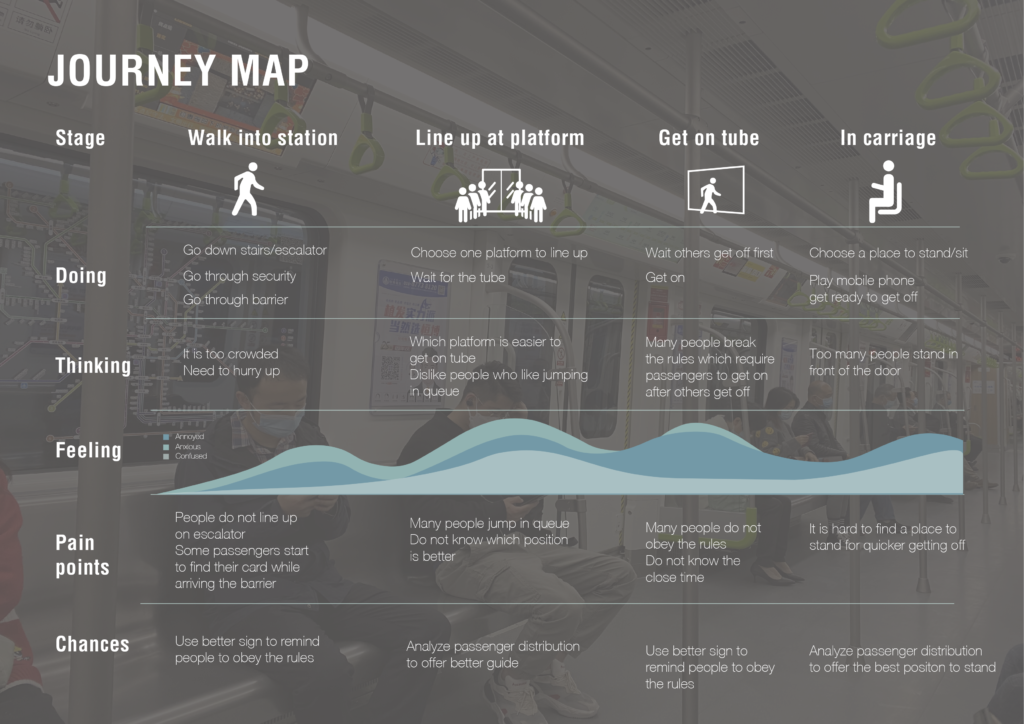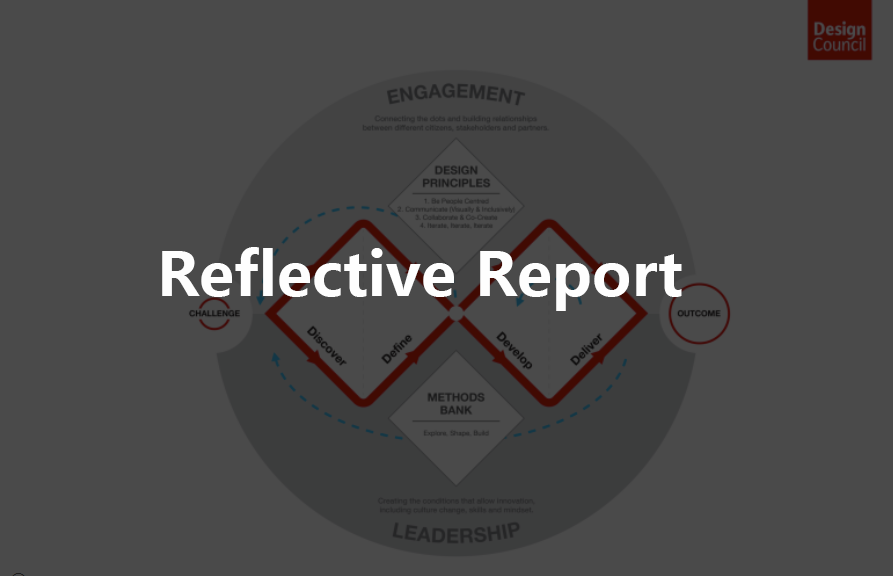Reflective report
Before I entered MACD, my understanding of interaction design was just that it was the design of user interface and web page using graphics in the context of the continuous development of the Internet. Firstly, I would focus more on the aesthetics of the interface, which made me encounter some difficulties in developing the project after I entered MACD. With the deepening of the course, I learned some model knowledge about conducting user demand research by reading relevant books shared by the teacher and class sharing. My cognition of interaction design also changed a little. I gradually understand that interaction design should focus more on users themselves, and designers should establish a direct relationship with users. For users, interaction design is a way to help them solve their needs and improve their quality of life. At the same time, designers need to consider the emotional needs of users more during the design process of each project. Emotional expression is an essential part of designers’ communication with users.
Describe––––what happened:
Before each class, the teacher will share the relevant course materials to read and study in advance. Before the design concept of each project, we will also receive project briefs, which describe the requirements and outputs of each project in more detail. Doing so will help us learn more effectively. We have completed four projects this semester. The first project is to make a map to show our experiences or hobbies. In the second project, I contacted the 5C model (Friis and Gelting, 2021) and double diamond(What is the framework for innovation? Design Council’s evolved Double Diamond, 2021).

5C model (Friis and Gelting, 2021)

(Design Council’s evolved Double Diamond, 2021)
These models are designed to help better conduct user research. In the early stage of the project, after the theme and target object are determined through observation and discovery, further background research is needed to collect the information of target users to obtain design insights.
In the Everyday People theme of Project 2, I choose people who take the subway everyday as the target group. The context of this project comes from some phenomena I have observed and experienced everyday when I take the subway — the subway station has a large flow of people. The passengers are concentrated in one carriage. Some wrong signals and order problems affect the compartment space of the subway, which leads to some accidents and makes the commuting time of the users longer. These observations and experiences have become the inspiration source of my project. Through observation, interview and research, we understand the pain points experienced by users on their daily subway ride, as well as their needs. At the same time, the collected data are analyzed.

In the third project, I chose to make a weather app for primary school students aged 7-11 to help them better understand the weather and learn weather knowledge. In this project, through the combination of primary research and secondary research, the demand and idea of the target population for the current weather software were understood. Meanwhile, competitive products of the same type were analyzed. And I made a paper film to test the rationality of the product function, which exercised my hands-on ability to a certain extent. In the construction of user modelling technology of the project, I have come into contact with research methods such as Persona, Journey Map and Empathy, among which, making Journey Map can better understand users’ feeling, thinking, and pain points at each stage. Create virtual personas and give them different identities and goals to get design inspiration more in line with users’ needs.

In the fourth project, I chose the theme of Conscious consumption. The target group is young people aged between 25 and 30 who raise a pet and live alone. I want to solve the damage caused by pets to the living environment because they have to leave the pet alone at home due to the removal of lockdown and the restoration of offline office. The physical and mental health of pets at home alone is damaged, which leads to pet owners having to spend extra money to pay for medical treatment and buy new furniture, etc., so I designed a pet recruitment app. When the owners go to work, they will also send their pets to the theme cafe to work to get better care. The hope is to help these pets thrive while maintaining the planet’s resources.
“Collaborate” is also a significant design phase because the team’s communication and coordination will help the design proceed better. Due to the epidemic, we used the online teaching mode in the first semester, but the tutor and students directly maintained good interaction and contact. When the project progresses to a particular stage, students will test each other to get feedback and constantly iterate and update to make the project more reasonable. Through the study of model technology, I also learned to think about problems dialectically.
I –––– Interpret the events
In China, teachers pay more attention to learning some skills and clearly emphasize each task’s design direction and output type. I am also accustomed to following the instructions of teachers to carry out projects. This also imprisons my thinking mode to some extent and makes me think about problems in a less profound dimension.
When I entered MACD, due to the change in my major, I could not immediately enter the learning state of a new major. Although some software I learned during my undergraduate study provided some help for my project design this semester, the teaching mode abroad is more liberal. The tutor will constantly push the way and Angle of thinking after guiding the direction of progress. Foreign teachers also pay more attention to the communication and exchange among students. For example, in the tutorial every Wednesday, we also watch each other’s group projects and give some feedback. Through the study this semester, I know that I still need to explore and learn more. I also understand that theoretical knowledge is only used as argument support, or it needs to be combined with practice. For different fields and projects, we should also provide relevant knowledge and skills for the products. I should combine the model knowledge I have learned to conduct user research in a more systematic and targeted way, establish a good relationship between design and users, and create a friendly user experience.
E——Evaluate the effectiveness and usefulness of the experience
Before starting this course, I thought that standard interaction design was about the direct interaction between people and computers and mobile phones, while the interface design was relatively simple. By completing the project this semester, I realized that interaction design could also have other forms of presentation. Our course is a combination of theoretical research and practice. When we learn new knowledge points and apply them to the project’s research process, we can deepen our understanding and absorption of knowledge. Through the completion of four projects this semester, I learned about the operation of the UI system. I understood the importance of prototype diagram testing, user feedback and product iteration in the design process. We should not only learn how to design apps, but we should also have design empathy. With Empathy in the design, it can better study and analyze target groups to obtain user needs. Empathy is also an essential factor in professional success at a company or job. In design research, we always need to understand the user’s needs, Learn the user’s pain points and feelings, Empathy and the user experience – Empathy in UX Design Video Tutorial | LinkedIn Learning, formerly Lynda.com, 2021).
Through the project research, I have a deeper understanding of user experience. I learned how to create products that help you achieve your goals and learned how to do design steps so that every design should meet your needs. At the same time, I also understood the importance of Sketchbook during the process because sketching is a way to establish a communication relationship with users quickly and to draw them into the whole design process actively. Thus, more reflective user feedback can be obtained (Tohidi, Buxton, Baecker and Sellen, 2006). This is a valuable asset in my life. When I meet similar problems in my future career, I will always use these theories to help me solve them better.
P –––– Plan how this learning will be applied
After a semester of study, I have a detailed understanding of the design steps, how to build a user model when carrying out a project, research and analyze data to promote the test of the project, and how to keep iterating until the final output. This knowledge also laid the foundation for my future career as an interaction designer. At the same time, I also have a clearer understanding of communication design, making me more confident to carry out the following courses.
As a designer, I followed the design concept of “human-centred” (Norman, 1986) and used it to rely on users rather than technology in every one of my designs. At the same time, I will always maintain the attitude of “Critical Thinking” (Elder and Paul, 2020). In the field of art and design, user needs are always the most crucial part. How to enhance user experience and make a plan to serve users is a problem every designer needs to think.
Reference list:
Design Council. 2021. What is the framework for innovation? Design Council’s evolved Double Diamond. [online] Available at: <https://www.designcouncil.org.uk/news-opinion/what-framework-innovation-design-councils-evolved-double-diamond> [Accessed 17 May 2021].
Elder, L., & Paul, R. (2020). Critical thinking: Learn the tools the best thinkers use. Foundation for Critical Thinking.
LinkedIn. 2021. Empathy and user experience – Empathy in UX Design Video Tutorial | LinkedIn Learning, formerly Lynda.com. [online] Available at: <https://www.linkedin.com/learning/empathy-in-ux-design/empathy-and-user-experience> [Accessed 14 May 2021].
Norman, D. and Draper, S., 1986. User centered system design. Hillsdale, N.J.: Lawrence Erlbaum.
Tohidi, M., Buxton, W., Baecker, R. and Sellen, A., 2006. User sketches. Proceedings of the 4th Nordic conference on Human-computer interaction changing roles – NordiCHI ’06,.
